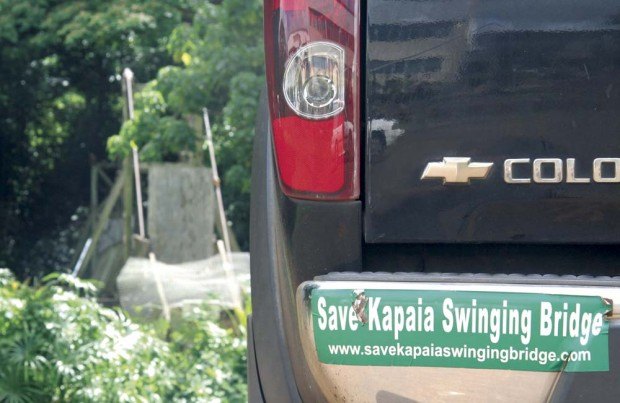LIHU‘E — Community members fighting to save the Kapaia Swinging Bridge left another Kaua‘i County Council meeting last week without hearing any answers from Mayor Bernard Carvalho Jr.’s administration. Kapaia residents are saying if work to stabilize the decaying bridge
LIHU‘E — Community members fighting to save the Kapaia Swinging Bridge left another Kaua‘i County Council meeting last week without hearing any answers from Mayor Bernard Carvalho Jr.’s administration.
Kapaia residents are saying if work to stabilize the decaying bridge is not done soon the historic structure may collapse, making its restoration more costly and difficult.
On June 11, Kapaia resident Kimo St. John asked the council to release $20,000 of the bridge’s $230,000 restoration fund to stabilize one the bridge’s wooden towers. The sagging steel cables are threatening to come down, and with some of the wood footing completely rotted away, there’s a “real possibility” the entire bridge will collapse, he said.
St. John said $20,000 would be sufficient to keep the bridge standing until funding for a full restoration is obtained.
On June 29, County Managing Director Gary Heu said he hoped the consultant would get back to the administration in two weeks regarding the feasibility of stabilizing the bridge.
“We can certainly press our consultant if we’ve not heard from them in about a week,” he said at the time.
Kapaia residents showed up at a council meeting on Wednesday, eager to hear the administration’s response on the feasibility of the bridge’s stabilization as posted on the agenda. But they were again caught off-guard by a deferral request.
“We respectfully request” a deferral on this item until Aug. 24, County Engineer Larry Dill said in a letter addressed to council members, dated the day before the meeting. “This will allow us time to gather information from our consultants and to review cost estimates.”
It wasn’t the first time the administration sent a last-minute deferral request.
Earlier this year, Kapaia residents showed up at a weekly council meeting only to find out that the administration had sent a deferral request the day before. Those who took off work to be present at the meeting were livid no one from the community had been notified.
The administration’s request last week for a six-week deferral didn’t sit well with the public.
Kapaia Foundation Director Laraine Moriguchi said it’s “a very long time.”
If the administration’s request stood, it would be 11 weeks from the first time St. John requested funding to stabilize the bridge.
But Councilwoman JoAnn Yukimura asked to defer for only two weeks a response from the administration on the bridge’s stabilization. The administration will still have until Aug. 24 to respond to other issues related to the bridge’s restoration.
Council Chair Jay Furfaro said there will be no further deferrals after Aug. 24.
Brief history
The county built the Kapaia Bridge in 1948. Pedestrians — plantation workers who used to live in the area — primarily used the bridge to access the Catholic Church on the other side of Kapaia Stream. The bridge, still owned by the county, is surrounded on both sides by private property.
The county has spent approximately $89,000 on a design and feasibility study with consultant Kai Hawai‘i. After Carvalho found out the restoration project would cost $4 million, he said the administration wouldn’t be pursuing the project.
But the community kept fighting, and the council put some money into the bridge’s restoration fund, bringing it back to $230,000.
A second look by the administration at the consultant’s findings brought the total cost of the project down to $2.1 million, which would leave the county with a new bridge without legal access to it.
On June 29 Angie Westfall, architecture branch chief of the State Historic Preservation Division, produced findings that stunned council members.
“It’s basically a Disneyland version of the bridge,” Westfall said of the bridge’s design that the administration had been considering. She explained that the plans presented to the administration look similar to the original bridge, but are different enough that, if followed, the bridge would not be historic anymore. The new plan called for a wider bridge with longer access ramps.
She also said that the bridge’s restoration should cost a lot less than what the consultant had come up with, and that there are many funding opportunities that the council could take advantage of.
• Léo Azambuja, staff writer, can be reached at 245-3681 (ext. 252) or lazambuja@ thegardenisland.com.



